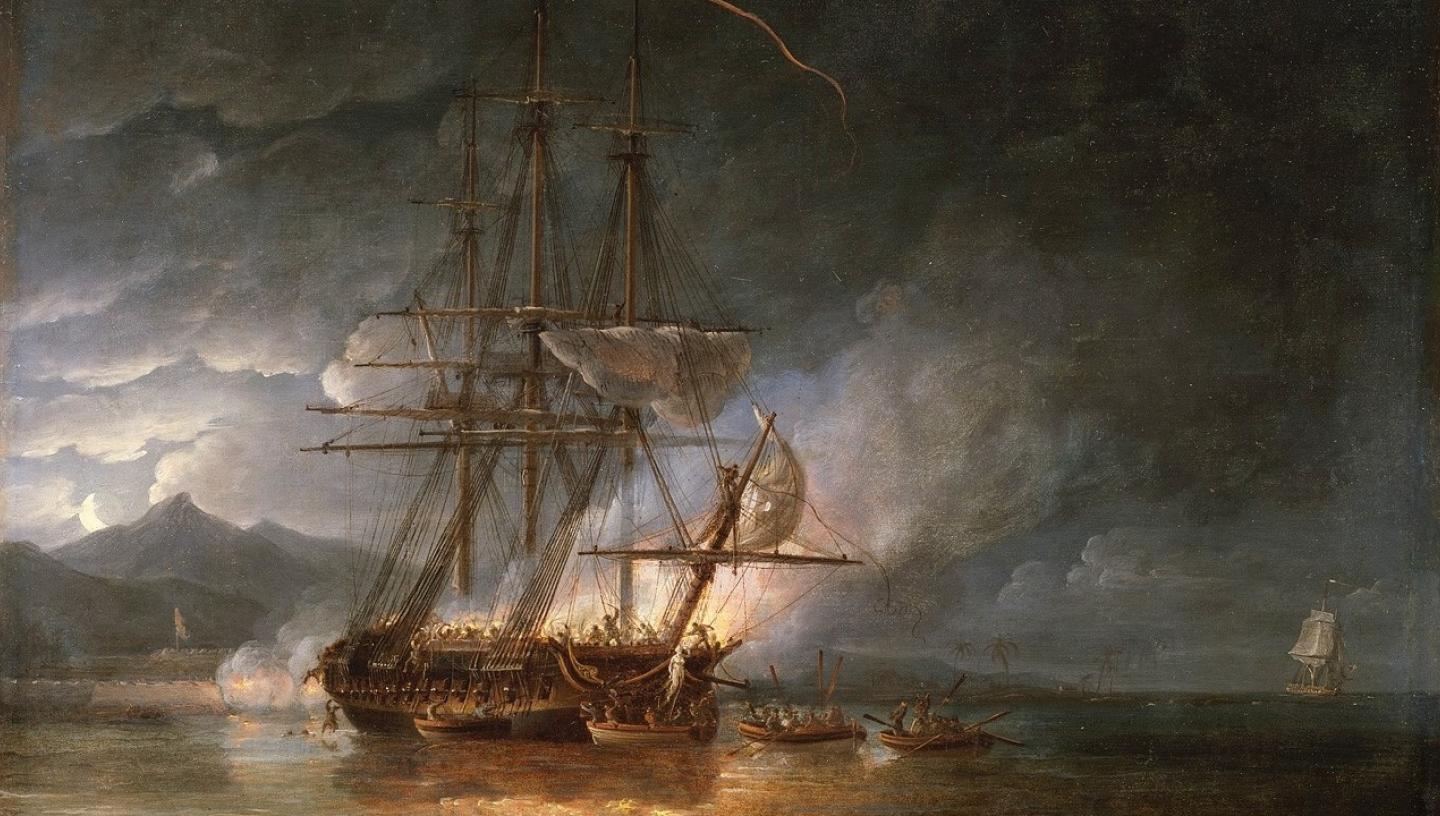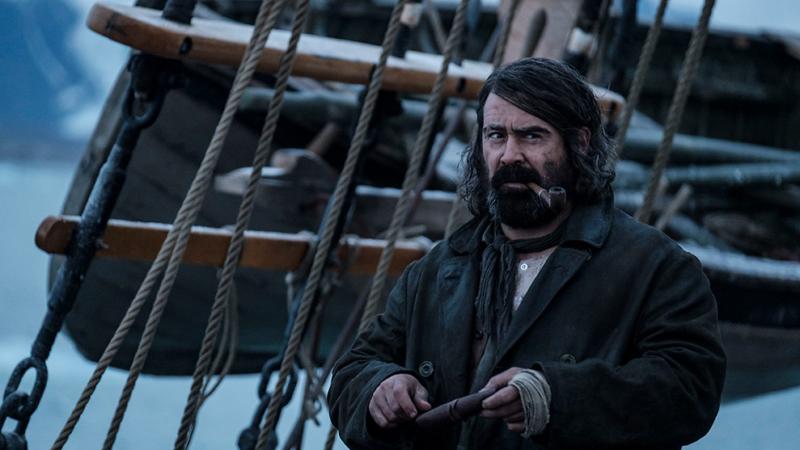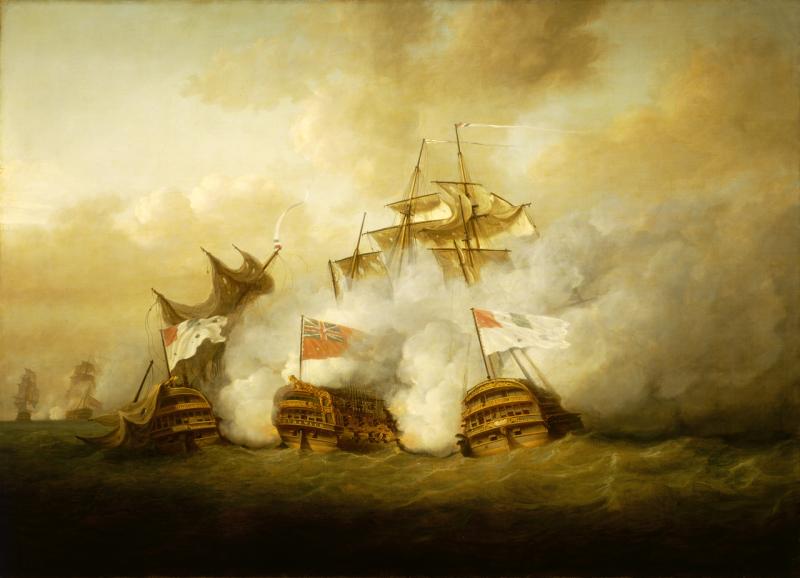
This Caird Library and Archive blog looks at the naval career of David O’Brien Casey and how he bore witness to one of the most horrific mutinies of the 18th century
An inauspicious beginning
David O’Brien Casey’s career seems to have been filled with bad luck. He entered the Navy in 1789 as a captain’s servant in the 24-gun Hyaena. On 27 May 1793, the ship was captured in the Caribbean by the French 40-gun frigate, Concorde, becoming the first British war loss. Casey was held prisoner with the crew at Cap-Français, Saint-Domingue.
It was here that he not only witnessed the massacre of the Battle of Cap-Français (1793), often being threatened with death himself, but during this time he lost his uncle John Casey, who had been serving on the same ship as a gunner.
“My loss may therefore be easily imagined being left in French Prison at a very early age (without parent, relatives or friends) to work my own way through life.”
When Casey was released, he found his way alone to Jamaica and joined the Hermione. Once again, he was hit by misfortune as half the crew were lost to disease over four months.
Casey’s career as a midshipman between the end of 1793 to 1798 saw him serve upon the Hermione, the Raisonnable and the Swiftsure. While transferring to the Swiftsure, he was in charge of a schooner laden with wine and was meant to sail it to meet his new ship at Cape Nicola Mole.
Unfortunately, on a very dark, wet and squally night, they mistook the harbour and struck some rocks at 2am. All but Casey and one other man (who had managed to scramble up the rocks to fetch help) perished.
“One man, an excellent good seaman, and good swimmer, held out for 9 or 10 hours, sinking within a few yards of me, unable to render him any assistance, wishing me goodbye and offering up a Prayer for my safety in the most feeling manner.”
Casey was discovered at 2pm by Swiftsure boats and finally reached his new vessel exhausted and having lost everything but the shirt and trousers he wore.
Misfortune struck again when Casey was appointed acting lieutenant on the Ambuscade under Captain Twysden - “a very strict and severe officer". In early January, 1798, the Ambuscade became entangled in the Silver Key coral reef while Casey was on morning duty.
After freeing themselves and limping back to Cape Nicola Mole, a court-martial tried Casey for negligently performing his duty and quarrelling with his captain. He was made a midshipman once again and transferred back to the Hermione, now under the command of Captain Hugh Pigot.
The mutiny
At the Battle of Jean-Rabel in 1797, the Hermione led a squadron that cut out nine ships and suffered no casualties. During this battle, Casey distinguished himself.
A popular man with the crew, Casey took his responsibilities seriously. He was the complete opposite of Captain Pigot, who, through his connections and patronage, rose to the rank of captain, despite apparently poor leadership skills and a reputation for brutality.
In September, about a week before the mutiny, Casey was at his station on the main top when Pigot, “who appeared to have drunk freely”, noticed that one of the sails had not been appropriately tied by one of the sailors under Casey's supervision. Confronted by Pigot, Casey apologised and took responsibility for the oversight.
“He instantly launched out in the most abusive and unofficer-like language, calling me a damned lubber, a scoundrel, a worthless good-for-nothing fellow, that I never did anything right and other severe expressions.”
Casey was ordered below and at 8pm brought before the captain and the first lieutenant, master and purser. Pigot demanded that Casey apologise again:
“If I did not go down on my knees the following morning publicly on the Quarter Deck, he would flog me most severely and in the most degrading way possible.”
When Casey refused to be humiliated twice, the captain ordered that he receive twelve lashes (more commonly a sailor's punishment than that of a junior officer). He was subsequently disrated, effectively ending his career as a naval officer.
Pigot’s practice of flogging was not limited to this incident. On 20 September 1797, he ordered the topsails to be reefed after a squall struck the ship. He was dissatisfied with the speed of the operation and gave the order for the last men off the yard to be flogged. In their haste to get down, three young sailors fell to their death on the deck.
One of the sailors hit and injured the master, Mr Southcott. The order was then given for the bodies to be thrown overboard and for two boatswain's mates to flog the rest of the topmen when they complained.
Following further unacceptable behaviour by the captain towards those working in the rigging, the crew were driven to mutiny on the evening of 21 September. The mutiny commenced at about 11pm among three different parties - against the lieutenant’s deck, captain’s cabin and gunroom.
“With a wild indescribable noise, and shouting, no resistance being made in any quarter, the ship was instantly in possession of the mutineers and the Captain, 2nd and 3rd Lieutenant and a Midshipman, at once murdered in the most savage and cruel manner. The party that attacked the Captain knocked down the sentry at the door and attacked the Captain as he jumped out of bed, all taking a cut or stab at him according to the weapons they were armed with.”
The mutineers then left the captain dying and joined those on the quarterdeck insisting on the death of the third lieutenant, Henry Foreshaw, who was an officer of the watch. He was cut and wounded severely and then thrown overboard.
The same party returned to the captain, put him to death and threw him out of his cabin window. The gunroom party murdered the second lieutenant, Archibald Douglas, and the midshipman. As the group dragged them up the hatchway dead, they cut and stabbed them with various weapons.
The mutineers then discussed what to do with the remaining officers. They considered sparing their lives until the rest of the crew (realising the officers were dead), gained access to the alcohol on board.
“The officers were brought on deck as their fate was decided some were wounded and thrown overboard and others thrown over unhurt, the language noise and scene altogether was horrible and not to be described, my life was repeatedly debated...”
Casey found his life protected by the original mutineers who had not partaken in the drinking.
“I was afterwards told by my friends that I was twice or thrice condemned and on the point of suffering and that it was with the greatest difficulty I was saved; two or three of them always kept near me as a protecting guard and removed me occasionally from place to place for more certain safety.”
Three warrant officers survived; the mutineers refrained from killing the gunner and carpenter because they were considered useful. Southcott, the master, was also spared as he was the only one left who could navigate. Southcott lived to be a key witness, along with Casey, and their eyewitness testimony was critical to the trials of many of the mutineers. Three petty officers joined the mutiny - one midshipman, surgeon's mate Cronin, and master’s mate Turner.
The aftermath
Fearing retribution for their actions, the mutineers decided to navigate the ship toward the Spanish port of La Guaira, where they handed the ship over to the Spanish authorities. They were given just 25 pounds each in return and presented with the option of joining the Spanish colonial army, heavy labour, or being employed in refitting their ship.
The Hermione was recovered years later by Captain Edward Hamilton. The Royal Navy vowed to hunt down the mutineers and, over the following decade, they found and executed two dozen of them. Casey was held prisoner for a few months until released. He was promoted to lieutenant on 11 October 1799 and served in the then East and West Indies and with the Sea Fencibles in Ireland.
On 6 December, 1835, he was placed in charge of the semaphore station at Putney and then, on 15 October, 1839, he was appointed to Greenwich Hospital.





